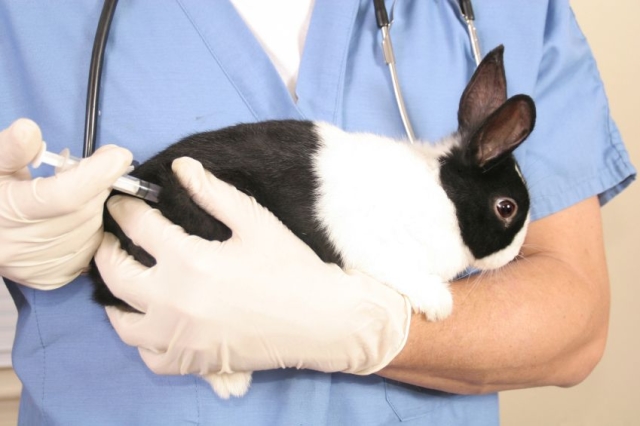Timely vaccination of rabbits is the only way to avoid mass death from infectious diseases.
For those who hold rabbits, you need to know when to vaccinate, at what age and at what time.
Table of contents
What diseases are dangerous for rabbits?
Have rabbits two types of dangerous diseases. They are not amenable to treatment and usually lead to death.
- Viral hemorrhagic disease of rabbits - UHD.
- Myxomatosis.
- Rabies.
VGBK
VGBK develops from 1.5 months and older. An animal develops hemorrhages in the lungs and the liver in the form of hemorrhages and congestions.
Once in the skin cells, the virus begins to multiply and with the flow of blood enters the liver and heart. The disease develops within 72 hours. If you find a sick animal, it should be urgently isolated from other animals.
Signs of disease:
- loss of appetite;
- miscarriages in females;
- discharge of mucus from the nose;
- the temperature of the animal rises to 40 degrees;
- death throes.
The dead animal should be taken to the laboratory for examination to make an accurate diagnosis. At autopsy, it is clear that the internal organs are swollen and filled with blood.
Myxomatosis
Myxomatosis - This is another dangerous disease for rabbits. The disease affects the anus, lower digestive tract, genitals and mucous heads.
The period of development is approximately 7 days.Virus animals are infected through the blood and contact method. Most often the disease is spread by blood-sucking insects.
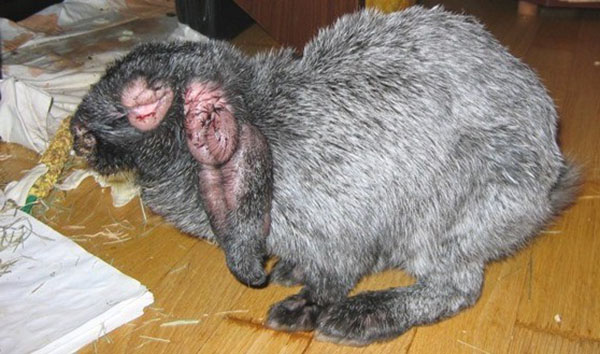
Signs of disease:
- Conjunctivitis is formed: the eyes and nose turn red. From the bottom, clear mucus stands out and crusts form.
- Tumors are formed all over the body: dense bumps appear all over the body in the latter stages of the disease.
- The animal wheezes and coughs.
- Nodular lesions appear in the anus and genitals.
Rabies
Rabies. A rare but still common disease in rabbits. It is dangerous for both animals and humans. Infection occurs through the skin and with deep penetration affects the nervous system.
Cure is impossible, which is fatal. The incubation period lasts from 7 to 14 days. Protection against the disease is prophylactic vaccination.
Signs of disease:
- excessive salivation;
- changes in behavior (they are either aggressive or too affectionate).
The scheme of vaccination against viral diseases
When vaccination is important age of the animalThe formation of immunity depends on it. It is advisable to protect animals from stressful situations, because it weakens the immune system.
The vaccine works as follows: in its composition there are pathogens and, when vaccination is given, the rabbit's body copes with them. Such individuals eventually develop immunity to viral diseases.
The first vaccination takes place at the age of 1.5 months.. If necessary, it is possible to make 3 weeks, but not recommended. Vaccination takes place at intervals of 6 months.
Only healthy individuals should be vaccinated.

With myxomatosis, the vaccine is placed once a year., because most often this disease is spread by insects. It is also recommended to follow certain rules so that vaccination is successful:
- Spring - for individuals from 4 weeks.
- After 1 month
- Autumn - 6 months after the first.
Adults are vaccinated every six months or once a year. In warm regions once in 6 months and in cold times 1 year.
Vaccinations against hemorrhagic disease:
- The first is introduced at the age of 1.5 months.
- after vaccination for myxomatosis, a vaccination is administered in two weeks.
- The next two are entered within 2 weeks.
- In the future, every 6 months.
Inoculate scheme:
- First time in 1.5 months
- The second time in 2 months.
- Repeat every 6 months.
Reasons why the vaccine does not work:
- Overdue vaccine.
- Sick animal.
- Violation of the vaccination scheme.
- Poor drug storage conditions.
- The rabbit is infected with parasites.
Inoculate an animal by the rules
In order for vaccination to benefit, some rules should be followed.
Animals must be healthy. If you see that the rabbit is lethargic and there is a suspicion of any disease, then it is better to postpone the vaccine and isolate the animal. Show it to the vet in order to make a diagnosis.
Before vaccination, read the instructions. Since it is constantly changing, then this should not be neglected.
Do not change the dosage yourself. Because in this case, the vaccine may not contribute and will not develop immunity to the disease.
Do not change the timing. Since immunity is developed for a certain period of time and if the terms are changed, the effect of the vaccine will be reduced to zero and will not bring any benefit.
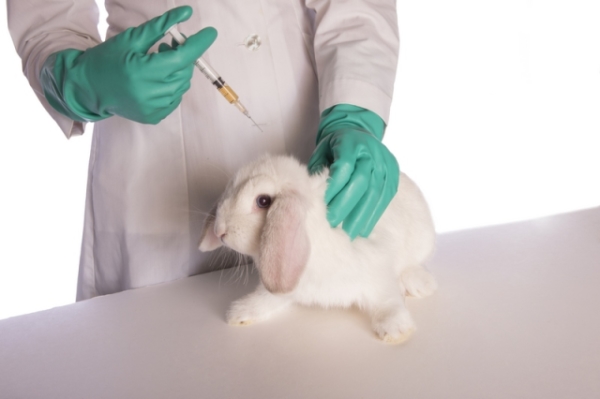
10 days before vaccination, animals should be wormed.: antihelminthic drugs should be given.
The weight of the rabbit must be at least 0.500 grams. Do not put the vaccine suckling females.
You may be interested in the following articles on the topic of rabbits:
The interval between vaccinations should not exceed 2 weeks.
Buy a vaccine at a veterinary pharmacyand not in pet stores and especially in the market. During the purchase ask about the conditions of storage, transportation. Do not forget to check the expiration date.
If you bought an adult individual who did not have a single vaccine, then do not worry. Give the animal all the appropriate vaccinations in the same way.
How to vaccinate a rabbit at home: instructions
When making a vaccination at home should be consideredthat this is a serious procedure:
- If you inoculate suckola to the female, then the babies will die in utero.
- A vaccination made to baby rabbits earlier than 3 weeks can lead to the death of the animal.
Therefore, before vaccination carefully read the instructions on the package. See shelf life and conditions.
Read the instructions for use, dosage and side effect. Also, vaccinations should be administered strictly according to the scheme.
How to vaccinate a rabbit yourself?
Self-vaccination is not difficult to do. Before it should carry out some procedures in order not to harm the rabbit:
- Swirl the animals this week.
- Sick rabbits should be isolated.
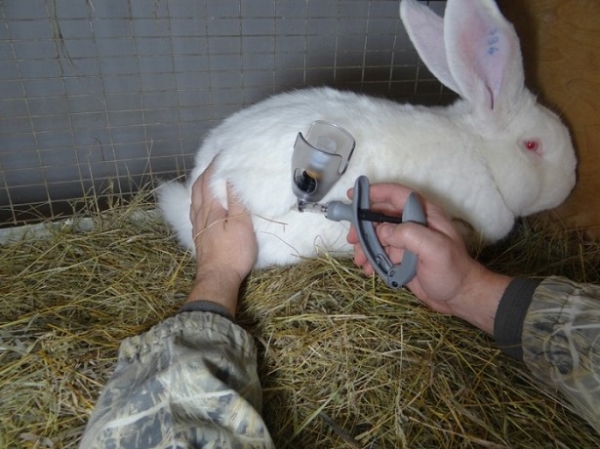
Put an injection better in withers, but possibly in thigh. With this procedure, hold the animal tightly.
The diluted drug is stored no more than 3 hours.
After you vaccinate the animal, keep him in quarantine for 14 days. After this time, there is less risk of infection.
Feeding animals is carried out as usual. Clean water should be always present in the cage.
Side effects are usually not observed.there is only increased salivation.Separate treatment is not required. All symptoms disappear after a few days.
Master class on vaccination of rabbits at a rabbit workshop at the Agro Animal Show exhibition. Conducts Belokon V.I. Candidate of Veterinary Sciences, Researcher of TOV "Bio-Test-Laboratory":
Vaccine Russian production
Associated vaccine against myxomatosis and viral hemorrhagic disease of rabbits dry.
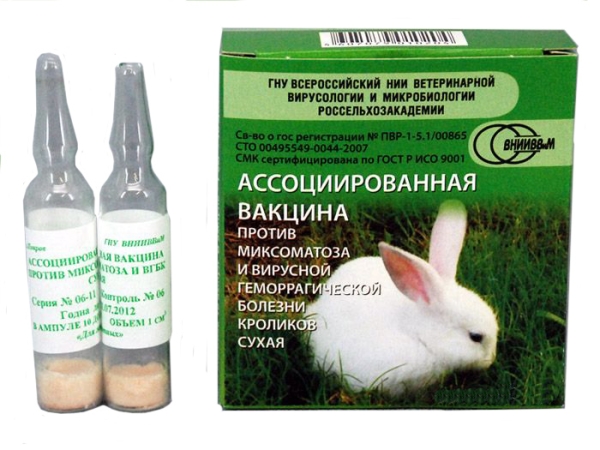
Myxomatosis Vaccine rabbits, dry, lively, cultural. Strain "B-82".
Tissue inactivated hydroxyl alumina vaccine against viral hemorrhagic disease.
RABBIVAK-IN. Vaccine against myxomatosis of rabbits attenuated. RABBIVAK-V. Against viral hemorrhagic disease of rabbits inactivated.
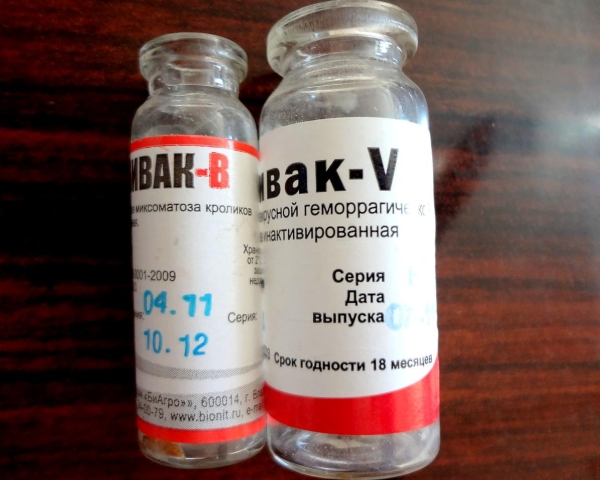
There are also drugs of foreign manufacture.
If on your farm after vaccination, animals die en masse and you can provethat the vaccine was not of high quality, then the manufacturer can be sued to the manufacturer to pay you compensation for the losses incurred.
But to sue, you can only on domestic producers.
Rabbit diseases are difficult to treat.. They are practically not amenable to treatment, so it is easier and more cost-effective to prevent diseases, especially dangerous ones.
A rabbit breeder should take care of the cleanliness and proper care of his pets. Same timely preventive vaccination of rabbits is requiredwhich will keep the livestock healthy and active.
